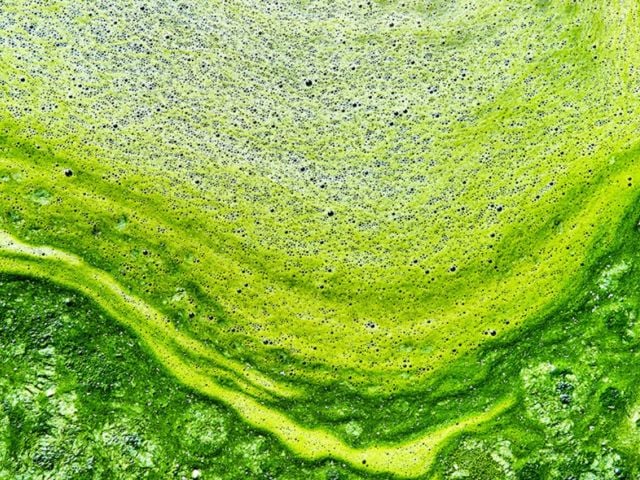
A new EWG interactive map shows results of state tests for the algae bloom toxin microcystin across Iowa, Minnesota and Wisconsin. Our analysis found that much more regular microcystin monitoring is needed in these three states to keep people safe from algae outbreaks.
Because testing is limited in all three states, the map also shows where there have been news reports of outbreaks of algae, from 2010 through September of 2020. A news story does not always confirm that the bloom was toxic, since in many cases, testing for algae toxins was not conducted, and it is impossible to know whether a bloom is toxic without testing.
Blue-green algae blooms are actually microscopic organisms called cyanobacteria. Cyanobacteria can produce multiple different toxins that are poisonous to people, pets and wildlife. Microcystin is one of the most common cyanotoxins, and exposure can lead to short-term human health symptoms like nausea, vomiting, diarrhea and sore throat, and long-term problems like liver failure and cancer. In these and many other states, algae blooms are commonly triggered when fertilizer and animal manure run off poorly protected farm fields and get into lakes, ponds, rivers and streams.
Iowa
The Iowa Department of Natural Resources only tests state park beaches for microcystin. The agency tests every week from Memorial Day through Labor Day and issues a “Swimming Is Not Recommended” advisory if microcystin exceeds the Environmental Protection Agency’s recreational water quality guideline for microcystin of 8 micrograms per liter, or ug/L.
Each of the 43 beaches tested since 2006 detected microcystin at least once. Of those, 33 beaches had at least one year that tested at or above 8 ug/L. Since 2010, 38 news stories reported on algae blooms in Iowa. Of those, 12 reports were written about bloom locations where the state has not tested for microcystin.
Iowa is the only state of the three where a state agency does routine monitoring for microcystin every year, but the testing program does not include very many locations. The state currently tests for microcystin at 39 state park beaches, but that is much fewer than the 846 lakes, reservoirs and ponds in the state.
Minnesota
The Minnesota Pollution Control Agency tested lakes and ponds for microcystin in 2006, 2007, 2009, 2012, 2016 and 2017. Microcystin was detected at 212 out of 302 locations tested.
Some lakes were tested in more than one location, so we cannot equate the number of locations tested to the number of lakes or ponds tested. Fifty-five locations had at least one year in which they tested at or above 8 ug/L. Between 2010 and 2020, 48 news reports were published about algae outbreaks in Minnesota. Thirty-five of those reports covered an outbreak in a location that the state had not tested for microcystin.
Minnesota does not have a program that tests for microcystin every year. The tests done in 2007, 2012 and 2017 were performed in conjunction with the Environmental Protection Agency’s National Lake Assessment, and the state also tested for microcystin through a number of small monitoring projects in 2006, 2007, 2009 and 2016. Today, bodies of water are tested for cyanotoxins only if there is a dog death or human health incident, or through the EPA. Minnesota has more than 11,800 lakes, yet fewer than 300 have been tested for microcystin since 2006.
Wisconsin
The map shows Wisconsin test results from two periods: 2010 to 2014 and 2018 to 2020. The Wisconsin Department of Natural Resources sends water samples to a lab for testing when a case of human or animal illness potentially caused by cyanotoxins is reported to the state Department of Health Services.
Microcystin was detected in 12 of the 20 locations tested since 2010. Four lakes had at least one year when they tested at or above 8 ug/L. Additionally, 39 news reports were written about an algae outbreak in Wisconsin since 2010. Of those, 29 locations were not tested by the state for microcystin.
Like Minnesota, Wisconsin does not have a routine monitoring program to test for microcystin every year. Through the Wisconsin Harmful Algal Bloom Surveillance Program, the state collects samples only when a human or animal illness potentially caused by cyanotoxins is reported to the state Department of Health Services. Since testing is conducted only in response to an illness report, the Wisconsin surveillance program does not capture the total picture of algae bloom issues in the state. Wisconsin has 15,000 lakes, but since 2010, only 20 were tested through this program.
More monitoring is needed to keep people safe
Although state-level testing is inadequate in these states and many others, state agencies performing the tests cannot be blamed for the shortfall. State legislatures rarely dedicate funds to widespread cyanotoxin testing, and federal support for testing nationwide is almost nonexistent. The only nationwide cyanotoxin testing is through the EPA’s National Lake Assessment, and that program only tests a small sample of lakes for microcystin every five years.
More monitoring is needed in Iowa, Minnesota and Wisconsin – as well as the rest of the country – to stop people from being exposed to toxic algae.



